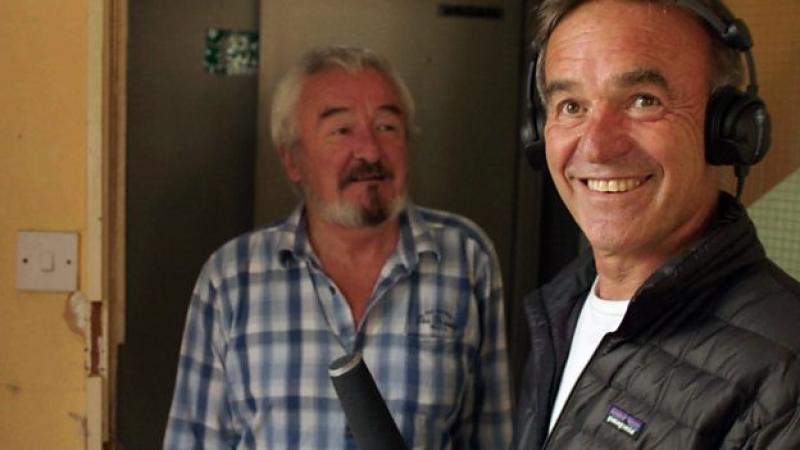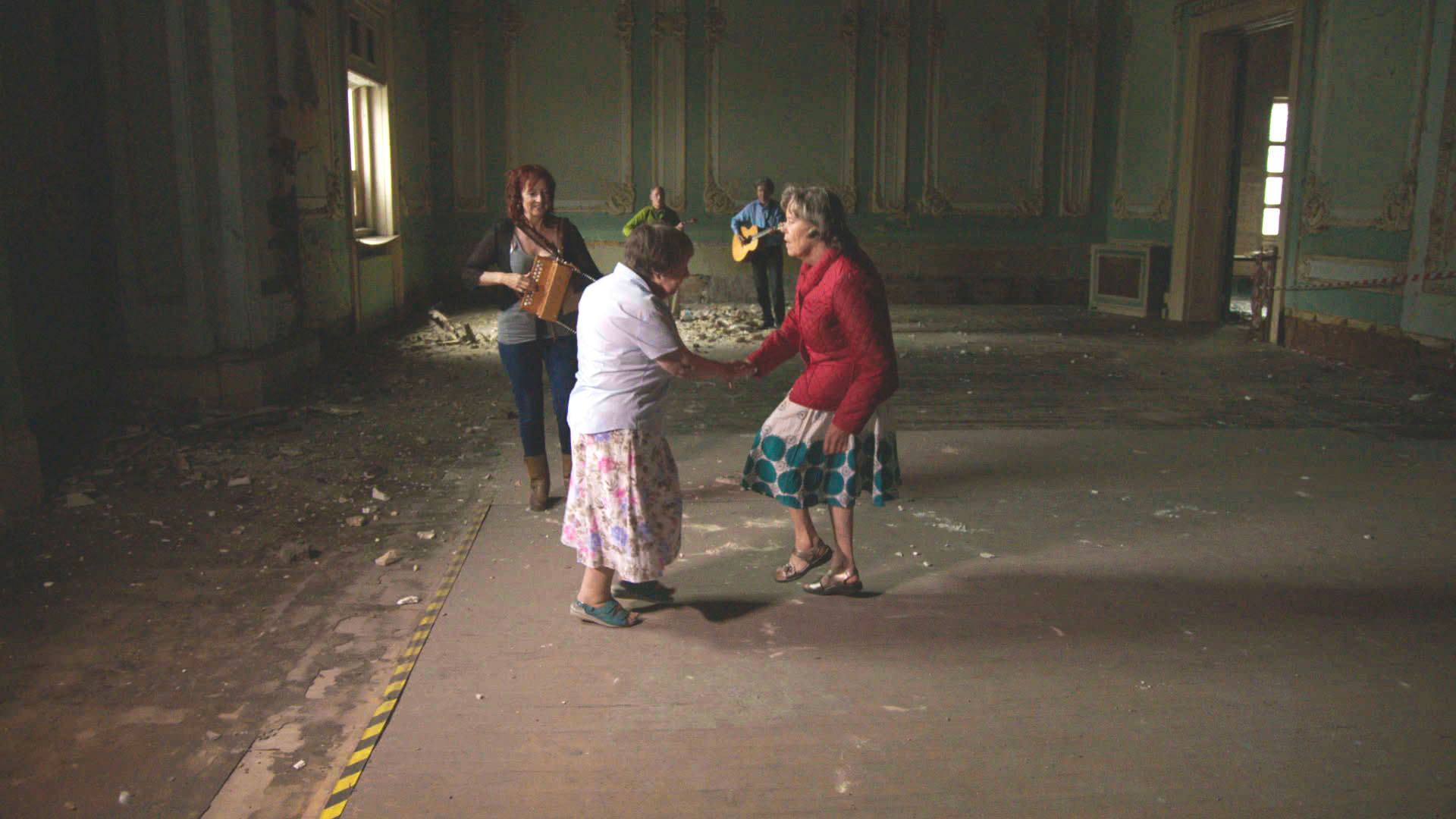Going Going Gone, BBC Four | reviews, news & interviews
Going Going Gone, BBC Four
Going Going Gone, BBC Four
Nick Broomfield in elegiac mode holds out for history

In Going Going Gone Nick Broomfield was fighting to get access all over again – but it wasn’t exactly the same kind of challenge he’d faced with Sarah Palin or some of his previous targets. Doors were closed, but the keepers of the keys here were anonymous local council functionaries, or the “media department” of Cardiff docks (who’d have known?).
Intimidating, it wasn’t. Instead the prevailing feeling behind these two films – distinct half-hour pieces that, for all their similarities, Broomfield left, like postcards home, as separate entities – was sadness. Should it surprise us that the sometime tyro presenter-director’s intonation here most closely recalled Philip Larkin's? He’d even taken his title from a Larkin poem, adding only that emphatic final “Gone” to complete the sense that we were all well on our way to hell already, chosen means of transport: handcart.
All we can do, Broomfield said, is pause, and listen for a minute But, as Larkin – or Betjeman, whose conservationist shadow surely loomed here, too – knew well, you can still have plenty of fun along the way on that particular route. Our journey through "Nick Broomfield's Disappearing Britain", as the film's subtitle had it, began at Liverpool’s Wellington Rooms, a grand piece of 1815 Greek Classical revival that started its days as a meeting place for the city’s super-rich, slave-traders included, before becoming in its final incarnation a social centre for the Irish community. For Broomfield it was a journey back in time in another way, too: he’d made his first film, “Who Cares”, back in 1969 in the area, charting the process of urban renewal that saw its community moved from Georgian houses into suburban tower blocks.
Did anyone care now? The council was more concerned lest a slab of the elaborate Adam ceiling or the Wedgwood frieze tumble onto Broomfield’s head if he was left in there on his own. Even his readiness to sign an indemnity form looked for a moment like it wouldn’t swing things: they could still be liable for manslaughter in civil proceedings, apparently. Eventually that was fixed (as we knew it was going to be) and we got some unrestricted time there with some of the people who did care, those for whom the Wellington Rooms had been a part of the fabric of their lives. “I just had to see dancing and hear music again,” Broomfield pronounced – a bit too commandingly, I thought – and he duly got a lovely closing scene as two old girls, lifelong best friends, twirled again together among the memories of their youth (pictured below).
 It all seemed depressingly familiar at our next stop, Cardiff’s Coal Exchange, a grand piece of late Victoriana from 1883 that once set world prices with its trades. Again, Broomfield was coming home: he’d been a student in the city in the 1960s, and remembered neighbouring Butetown, the community around the docks where 50 nationalities once lived in complete racial harmony. Changed utterly. We got memories of better days, but here at least someone was sticking up for the old place, even if that someone was Ian (main picture, with Broomfield), who admitted it was all becoming a bit of an obsession.
It all seemed depressingly familiar at our next stop, Cardiff’s Coal Exchange, a grand piece of late Victoriana from 1883 that once set world prices with its trades. Again, Broomfield was coming home: he’d been a student in the city in the 1960s, and remembered neighbouring Butetown, the community around the docks where 50 nationalities once lived in complete racial harmony. Changed utterly. We got memories of better days, but here at least someone was sticking up for the old place, even if that someone was Ian (main picture, with Broomfield), who admitted it was all becoming a bit of an obsession.
Health and safety proved just as recalcitrant about access, making for a scene where Ian, who had the keys, had to block Broomfield’s way. Should he force his way through, the director wondered, before he was threatened off by the prospect of a rugby tackle by the Coal Exchange’s lone defender? As opponents went, it has to be said, Ian wasn’t exactly in the same league as some of Broomfield’s past sparring partners, the white supremacist Eugène Terre’Blanche and his guards among them (and Nick was firmly on Ian's side anyway). Finally Broomfield got in over a fence, a piece of trespass that was as unnecessary as it must have been irresistible. Talking of unauthorised access, Going Going Gone managed some nifty camera work that must have been filmed from a drone, catching unusual high angles and swooping perspectives.
Do these two relics of grander years stand a chance? The fact that both are Grade II-listed by English Heritage doesn’t make anything easier: it only made the cost of any proposed improvements, someone at the Wellington Rooms remarked, go up. The cynical word on the ground was that when councils face such challenges – historic buildings prohibitively expensive to restore, which offer sites all too tempting for developers – they let them fall into dangerous neglect and then “pray for a high wind”. Larkin got it just right: “Greeds/And garbage are too thick-strewn/To be swept up now.” All we can do, said Broomfield, as he stood behind the grand old clock still ticking away in the Cardiff building, is pause, and listen for a minute. Going Going Gone did just that, rather nicely.
rating
Explore topics
Share this article
Add comment
The future of Arts Journalism
You can stop theartsdesk.com closing!
We urgently need financing to survive. Our fundraising drive has thus far raised £49,000 but we need to reach £100,000 or we will be forced to close. Please contribute here: https://gofund.me/c3f6033d
And if you can forward this information to anyone who might assist, we’d be grateful.

Subscribe to theartsdesk.com
Thank you for continuing to read our work on theartsdesk.com. For unlimited access to every article in its entirety, including our archive of more than 15,000 pieces, we're asking for £5 per month or £40 per year. We feel it's a very good deal, and hope you do too.
To take a subscription now simply click here.
And if you're looking for that extra gift for a friend or family member, why not treat them to a theartsdesk.com gift subscription?
more TV
 Murder Before Evensong, Acorn TV review - death comes to the picturesque village of Champton
The Rev Richard Coles's sleuthing cleric hits the screen
Murder Before Evensong, Acorn TV review - death comes to the picturesque village of Champton
The Rev Richard Coles's sleuthing cleric hits the screen
 Black Rabbit, Netflix review - grime and punishment in New York City
Jude Law and Jason Bateman tread the thin line between love and hate
Black Rabbit, Netflix review - grime and punishment in New York City
Jude Law and Jason Bateman tread the thin line between love and hate
 The Hack, ITV review - plodding anatomy of twin UK scandals
Jack Thorne's skill can't disguise the bagginess of his double-headed material
The Hack, ITV review - plodding anatomy of twin UK scandals
Jack Thorne's skill can't disguise the bagginess of his double-headed material
 Slow Horses, Series 5, Apple TV+ review - terror, trauma and impeccable comic timing
Jackson Lamb's band of MI5 misfits continues to fascinate and amuse
Slow Horses, Series 5, Apple TV+ review - terror, trauma and impeccable comic timing
Jackson Lamb's band of MI5 misfits continues to fascinate and amuse
 Coldwater, ITV1 review - horror and black comedy in the Highlands
Superb cast lights up David Ireland's cunning thriller
Coldwater, ITV1 review - horror and black comedy in the Highlands
Superb cast lights up David Ireland's cunning thriller
 Blu-ray: The Sweeney - Series One
Influential and entertaining 1970s police drama, handsomely restored
Blu-ray: The Sweeney - Series One
Influential and entertaining 1970s police drama, handsomely restored
 I Fought the Law, ITVX review - how an 800-year-old law was challenged and changed
Sheridan Smith's raw performance dominates ITV's new docudrama about injustice
I Fought the Law, ITVX review - how an 800-year-old law was challenged and changed
Sheridan Smith's raw performance dominates ITV's new docudrama about injustice
 The Paper, Sky Max review - a spinoff of the US Office worth waiting 20 years for
Perfectly judged recycling of the original's key elements, with a star turn at its heart
The Paper, Sky Max review - a spinoff of the US Office worth waiting 20 years for
Perfectly judged recycling of the original's key elements, with a star turn at its heart
 The Guest, BBC One review - be careful what you wish for
A terrific Eve Myles stars in addictive Welsh mystery
The Guest, BBC One review - be careful what you wish for
A terrific Eve Myles stars in addictive Welsh mystery
 theartsdesk Q&A: Suranne Jones on 'Hostage', power pants and politics
The star and producer talks about taking on the role of Prime Minister, wearing high heels and living in the public eye
theartsdesk Q&A: Suranne Jones on 'Hostage', power pants and politics
The star and producer talks about taking on the role of Prime Minister, wearing high heels and living in the public eye
 King & Conqueror, BBC One review - not many kicks in 1066
Turgid medieval drama leaves viewers in the dark
King & Conqueror, BBC One review - not many kicks in 1066
Turgid medieval drama leaves viewers in the dark
 Hostage, Netflix review - entente not-too-cordiale
Suranne Jones and Julie Delpy cross swords in confused political drama
Hostage, Netflix review - entente not-too-cordiale
Suranne Jones and Julie Delpy cross swords in confused political drama

Comments
I doubt English Heritage
Having enjoyed most of
Having enjoyed most of Broomfield's work over the years (whilst increasingly irritated by his narcissistic insistence on appearing in shot at every opportunity) I must say that having watched the first 40 minutes or so of "Going Going Gone" I was appalled by just how thin this effort is. The constant repetition of a few variants of shots of the disintegrating building couldn't disguise the fact that the material content of the film could have been delivered in a sucinct 15 minutes or so.
Really, p!55 poor stuff.